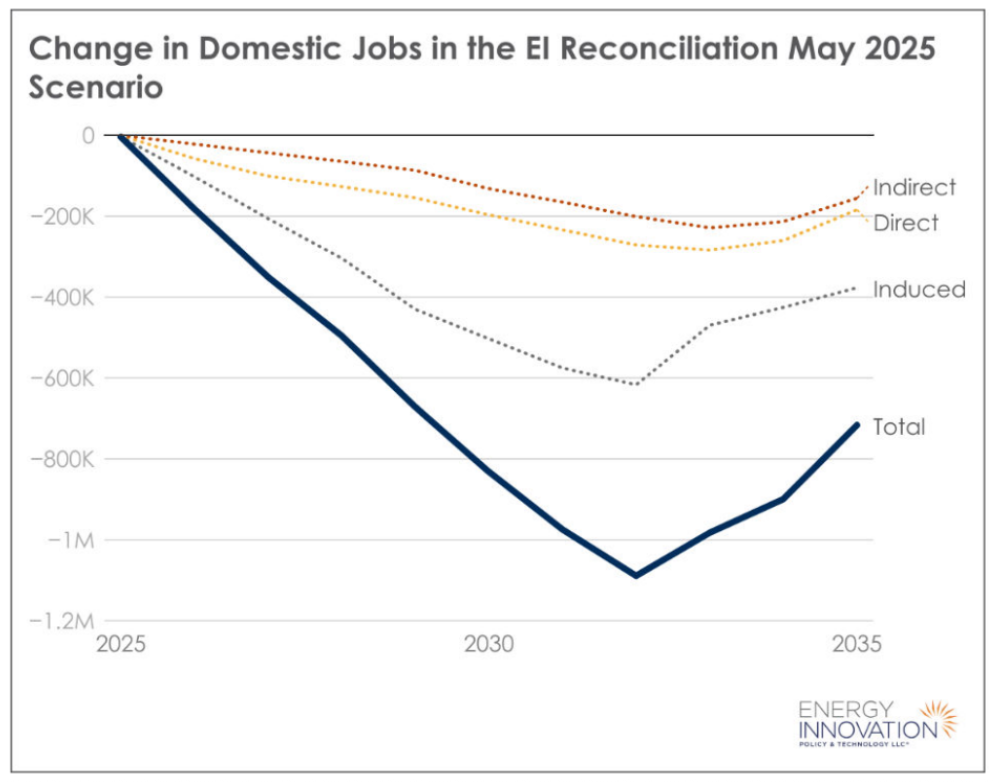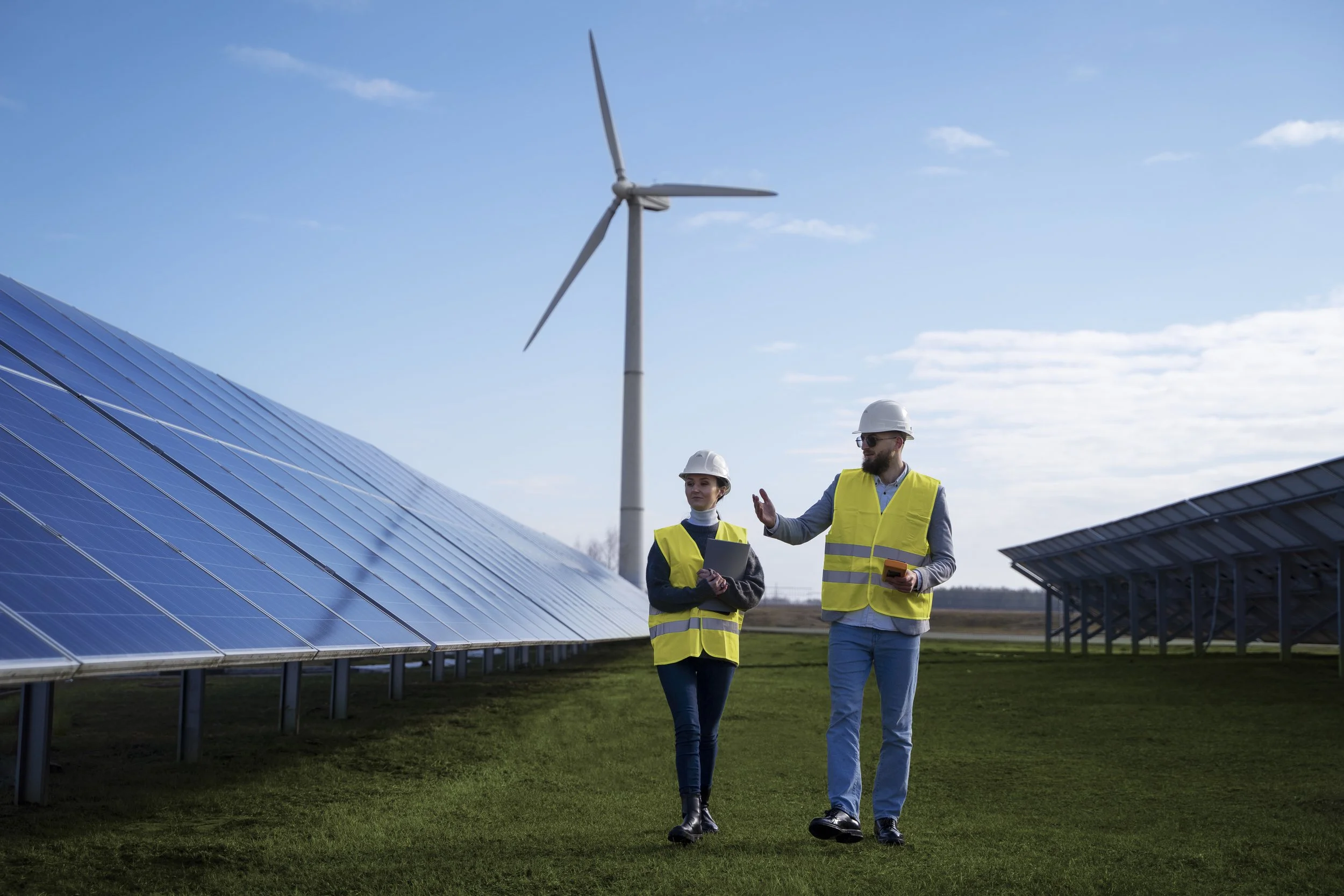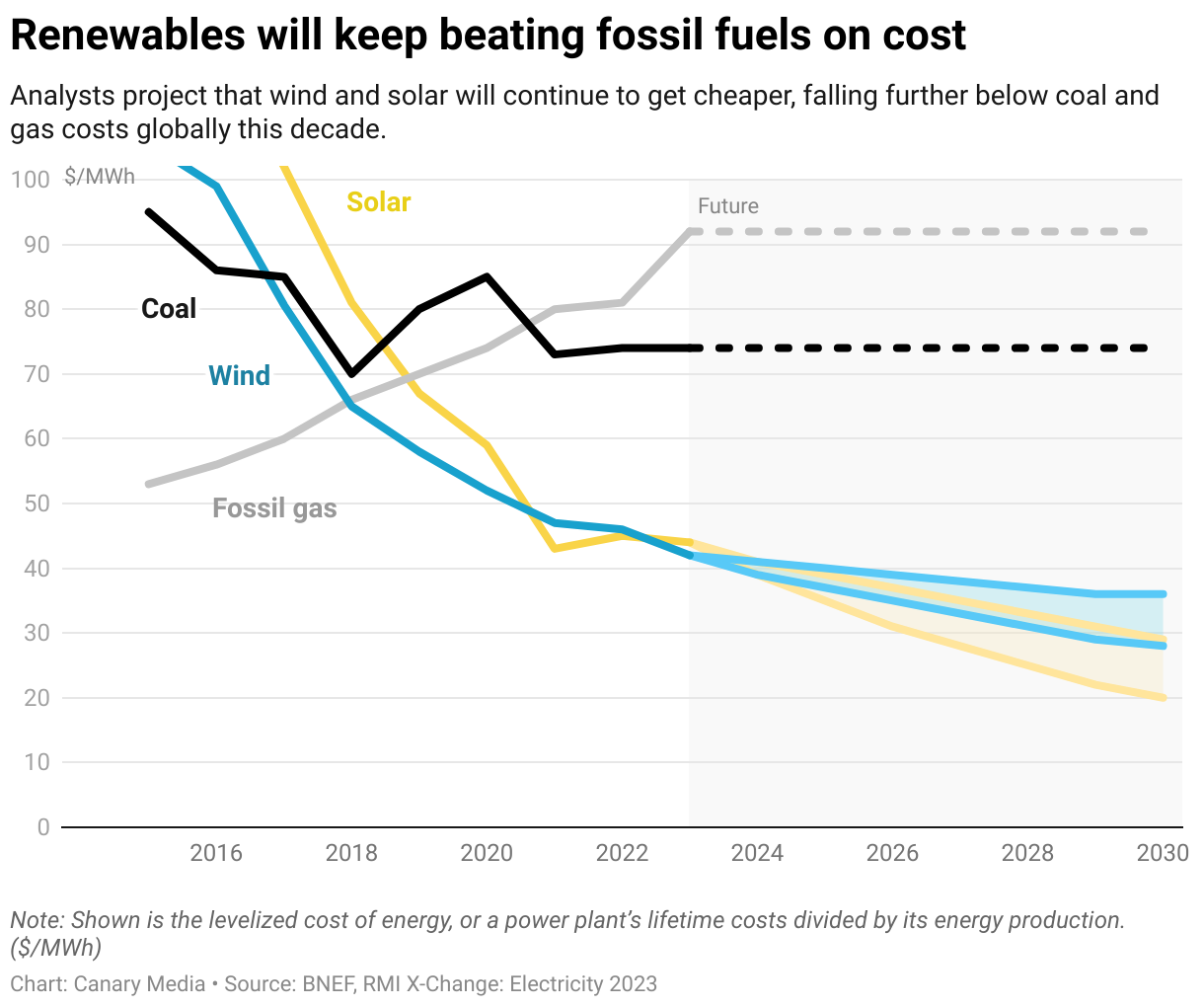“Solving the climate crisis is within our grasp, but we need people like you to stand up and act.” - Al Gore, 2007.
“If God had intended to give us unlimited free energy, he would have put a giant furnace in the sky.” - Al Gore, 2025.
By Luke Singer and Gautam Wadhwa
What will the “One Big Beautiful Bill” mean for federal healthcare programs?
The new tax and spending reconciliation bill, dubbed the “One Big Beautiful Bill” (OBBB), fails to maintain existing entitlement programs that workers in the United States already pay for through their taxes. [1] The Act was put into law on Independence Day, scaling back and redistributing federal resources in a manner that will leave many Americans with less affordable healthcare, fewer jobs in key industries, and higher energy costs. [1]
The backlash mainly stems from the bill's cuts of more than $1 trillion from Medicaid over the next decade, making it the most significant Medicaid rollback in history. [2, 3] This means the federal health insurance program will no longer be able to provide free or low-cost coverage to low-income individuals and families, including children, seniors, and people with disabilities. [3]
While the bill doesn’t cut funding for Medicare, a federal health insurance program that covers people aged 65 and older, as well as some younger individuals with disabilities, it will have a lasting impact. [4] The OBBB is estimated to add $3 to $4 trillion to the federal deficit over the next decade, which could trigger automatic cuts to government spending programs. [5, 6] Fortunately, Medicare is capped at a 4% cut under this rule; however, other programs, including student loan subsidies, agricultural programs, and public health initiatives, can be cut even more deeply. [7]
What this ultimately means is that healthcare will be more expensive and less accessible for seniors in the long term. This bill could endanger the lives of twelve million U.S. citizens by the end of the next decade, according to the Congressional Budget Office. [8]
Photo by Pixabay
How will the “One Big Beautiful Bill” impact the U.S. job market?
On a brighter note, the OBBB introduced tax cuts and enhanced small-business deductions, which may stimulate the economy and support near-term job creation, particularly for smaller businesses in the retail and hospitality sectors. [1] Additionally, infrastructure-related tax incentives may spur hiring in construction and manufacturing, with effects potentially materializing by 2026. [1]
While positive in the short term, many tax breaks in the bill are set to expire after the 2028–29 fiscal year. [1] It also slashes key clean-energy and social spending, introducing a risk of significant job loss. [1, 8] According to Energy Innovation, a non-partisan energy policy NGO, in less than 5 years, the OBBB may result in 830,000 U.S. jobs lost in the clean energy sector while also increasing personal energy costs for consumers and businesses. [9]
The graph below illustrates the direct and indirect job losses resulting from decreased investments in clean energy projects and lower demand for their inputs, as well as from induced economic activity (e.g., high fuel costs mean consumers have less money to re-spend in the economy). [9]
[9]
Those job losses would reverse recent growth. [10] In 2023, the U.S. Department of Energy reported that jobs in renewables grew at twice the rate of the already strong U.S. labor market. [10] Additionally, renewable energy projects create three times more jobs per unit of electricity generated or per dollar invested than fossil fuel-based sources, including coal, oil, and natural gas. [10]
Renewable energy technologies, such as solar panels, wind turbines, hydropower systems, and geothermal systems, have the potential to benefit the job market as the industry requires manual labor that cannot be outsourced or replaced with artificial intelligence. [11] Pollution-causing fossil fuel plants are more centralized sources of energy, whereas renewable energy systems are distributed across rooftops, fields, and remote areas. [11] More systems mean more local labor is needed for installation and maintenance. These jobs offer good salaries, stability, and don’t expose workers to carcinogenic substances like particulates. [11, 12] Best of all, renewables are increasingly outcompeting fossil fuels in terms of cost efficiency, despite relying on more labor and less capital. [13]
Photo by Kindel Media
How will the “One Big Beautiful Bill” impact renewable energy jobs, home electricity, and clean energy investments?
The OBBB is expected to end most federal tax credits for residential solar and battery storage by early 2026. [14] These credits have been around for 20 years. [15] Commercial solar incentives will face accelerated phase-outs. [14] Such a change will unequivocally shift the landscape for renewable energy in the U.S.—and not for the better. Cutting tax credits for wind, solar, and battery storage won’t just pinch the wallets of renewable energy producers; the effects will ripple out to every American household. [16] Without the financial cushion of subsidies, renewable energy projects will become more expensive, and those rising costs will translate into higher energy bills for consumers, adding a new layer of inflationary pressure to the economy. [16]
The Energy Innovation report compared two scenarios: one with the OBBB and one without. [9] The data reflects shifts in household and vehicle fuel spending across all energy sources (including gasoline and natural gas) but notes that most of the rising costs are tied to electricity and natural gas. [9] In the scenario with the OBBB, wholesale power prices are expected to increase by roughly 50 percent by 2035 due to the loss of new generation capacity. [9, 17] Cumulative annual consumer energy spending will increase by more than $16 billion in 2030 and by more than $33 billion by 2035. [9, 17] This means that, on average, each household will spend up to $640 more per year on electricity by 2035, with variations by state. [9, 17]
Photo by Pixabay
Some households may avoid these price hikes by transitioning to renewable energy sources earlier. Still, no one’s wallet is safe if the U.S. government continues to acquiesce to fossil fuel lobbying. It shouldn’t be a surprise that academics established that the cost of energy is linked to the quality of life. [18] This expenditure should be used on food, housing, and other necessities instead of inflated, fossil-fuelled home electricity and gasoline.
The fallout doesn’t stop at America’s borders. By making clean energy investments riskier and less attractive at home, the OBBB could inadvertently make American sustainable investments appear less appealing to international investors who are already concerned about uncertainty, at least in the short term. [19] While green investors are pulling out of the U.S., other countries may become new hotspots for renewable energy dollars, leaving the U.S. behind in the global race toward a cleaner future. [19]
In 2024, China was responsible for more than 50% of the global new power-generating capacity from wind and solar power. [20] Its economy has already matured past peak crude oil demand, according to the Energy Institute. [20] China will only extend its vast lead in energy dominance once the OBBB is in effect. [19, 20] And as the global competition for artificial intelligence dominance is, to some extent, a competition of energy capacity to train and power large language models like ChatGPT, the bill also threatens future American technological influence.
Photo from Freepik
Can clean energy keep the lights on now that the “OBBB” has passed?
Even though the OBBB impedes federal support for renewable energy, there are still strong forces at play that will keep the clean energy movement alive and well in the United States. For starters, many states—like California, New York, and Massachusetts—aren’t waiting for Washington to lead the charge. [21, 22, 23] They’ve rolled out their own ambitious programs to encourage solar and wind energy, offering everything from rebates to grants and tax breaks. [21, 22, 23] These local incentives can make a significant difference for homeowners and businesses eager to adopt green practices.
Utility companies are also stepping up. Across the country, some are offering incentives to keep green projects financially attractive in the face of fading federal tax credits. These incentives include net metering and a billing arrangement that allows customers generating their own power to receive credits for the excess electricity they send back to the grid, thereby reducing their utility bills. [24] Additionally, some states are implementing feed-in tariffs, which provide guaranteed payments to renewable energy producers for each unit of electricity they generate and feed into the grid, often at a premium rate. [25]
Some areas are introducing special rates for renewable energy, providing preferential pricing or contracts for electricity generated from clean sources. [26] Meanwhile, institutions including corporations, universities, and municipalities are making commitments to sustainability. [27, 28, 29] With long-term savings and a cleaner environment in mind, they’re investing in renewable energy sources regardless of what happens on Capitol Hill. These commitments not only cut emissions but also create stable jobs, from solar panel installers to energy auditors.
Even better, the technology itself is becoming increasingly affordable by the year. The cost of solar panels, wind turbines, and battery storage continues to drop, making renewable projects more affordable and accessible on their own. In 2024, the cost of residential solar panel installations decreased by 30% year-over-year. [30, 31] Meanwhile, utility-scale solar farms saw their levelized cost of energy (LCOE) drop by 21%, and concentrated solar power (CSP) costs decreased by 70%. [32] Onshore wind LCOE also continues to decline. [33] Studies show wind-generated electricity is now often cheaper than new gas or coal plants. [34] Finally, in 2024, the global benchmark cost for utility-scale battery storage fell by one-third, and grid-scale lithium-ion battery costs dropped by 90%. [35]
Chart showing projected $/MWh for various energy sources:
[13]
Community solar programs are another bright spot: by pooling resources, more people can enjoy the benefits of solar power without having to install panels on their rooftops. [36, 37] State policies often facilitate the establishment of these collective arrangements. [36] One example is the Brooklyn Microgrid, which began in 2016, allowing members to save money on electricity while also feeling empowered and mutually supported in their energy consumption. [37]
Innovative financing is also key in sustaining momentum. New models, such as solar leases and power purchase agreements, allow individuals and businesses to spread the cost of renewable energy over time, reducing the need for significant upfront investments. [38, 39] These are not simple accounting tricks, but rather a practical approach for everyday people to live better lives. [38, 39] And with forward-thinking firms like Etho Capital leading the way by investing in companies based on their climate efficiency, there’s even more reason to be optimistic about the future of renewable energy.
Photo by Pixabay
By selecting firms based on operational efficiency and rigorous sustainability criteria, we, at Etho Capital, prove that you don’t have to sacrifice returns to make a positive impact on the planet. [40] Our approach includes creating indices and investment products that exclude fossil fuels and prioritize innovation.
In a landscape where policy uncertainty can rattle markets and economies, it is even more critical that consumers and investors take care to understand how their tax dollars are spent and how their capital is allocated. Investing in organizations and companies that prioritize clean energy, worker protections, and responsible governance enables taxpayers to build an economy that supports climate resilience and human well-being, which are inextricably linked.
To do anything less is folly.
Photo by Stein Egil Liland
Sources:
Arrington, J. (July 4th, 2025). H.R.1 - One Big Beautiful Bill Act. United States Congress. https://www.congress.gov/bill/119th-congress/house-bill/1/text
Chait, J. (July 1st, 2025). They Didn’t Have To Do This. The Atlantic. https://www.theatlantic.com/politics/archive/2025/07/big-beautiful-bill-backlash/683390/
Brownstein Client Alert (July 8th, 2025). Final Healthcare Provisions in the “One Big Beautiful Bill Act”. Brownstein. https://www.bhfs.com/insight/final-health-care-provisions-in-the-one-big-beautiful-bill-act/
Ornstein, N. (July 16th, 2025) Medicaid Cuts? Yes. But the GOP Is Also Quietly Cutting Medicare, Too. The National Republic. https://newrepublic.com/article/197992/republican-trump-budget-bill-cuts-medicare-too
Committee For a Responsible Federal Budget. (June 4th, 2025) Breaking Down The One Big Beautiful Bill. https://www.crfb.org/blogs/breaking-down-one-big-beautiful-bill
Duehren, A. (July 2nd, 2025). Senate Bill Would Add At Least $3.3 Trillion To Debt, Budget Office Says. The New York Times. https://www.nytimes.com/2025/06/29/us/politics/senate-bill-trump-cbo-score-debt.html
Swagel, P. (May 20th, 2025). Potential Statutory Pay-As-You-Go Effects of a Bill to Provide Reconciliation Pursuant to H. Con. Res. 14, the One Big Beautiful Bill Act. United States Congressional Budget Office. https://www.cbo.gov/system/files/2025-05/61423-PAYGO.pdf
Drenon, B. & Yousif, N. (July 4th, 2025). What are the key items in Trump's sprawling budget bill? British Broadcasting Corporation. https://www.bbc.com/news/articles/c0eqpz23l9jo
Energy Innovation. (June 11th, 2025). Assessing Impacts of the 2025 Reconciliation Bill On U.S. Energy Costs, Jobs, Health, and Emissions https://energyinnovation.org/wp-content/uploads/Impacts-Of-2025-House-Reconciliation-Bill-On-U.S.-Energy-Costs-Jobs-Health-Emissions.pdf
United States Department of Energy. Job Creation and Economic Growth. Retrieved July 18th, 2025 from https://www.energy.gov/eere/job-creation-and-economic-growth
Miller, J. How is Renewable Energy Creating Jobs? MacKinnon & Partners. Retrieved July 18th, 2025 from https://mackinnonandpartners.com/how-is-renewable-energy-creating-jobs/
Noguiera, L. (December 30th, 2023). Fossil Fuels Present Considerable Cancer Risks. Targeted Oncology. https://www.targetedonc.com/view/fossil-fuels-present-considerable-cancer-risks
Takemura, A. (September 1st, 2023). Chart: Renewables are on track to keep getting cheaper and cheaper. Canary Media. https://www.canarymedia.com/articles/clean-energy/charts-renewables-are-on-track-to-keep-getting-cheaper-and-cheaper
Hopper, C. (June 24th, 2025). Trump’s ‘One Big Beautiful Bill’ is one big betrayal of American energy progress. Fortune. https://fortune.com/2025/06/24/solar-energy-tax-credits/
Lozanova, S. (July 13th, 2025). The History & Future of the Solar Tax Credit in 2025. Green Lancer. https://www.greenlancer.com/post/solar-energy-tax-credit-2025
Clean Energy Buyers Association. (February 25th, 2023). CEBA Report: Repealing Clean Energy Tax Credits Would Raise Electricity Prices for American Families and Job Creators Across the United States. https://cebuyers.org/blog/ceba-report-repealing-clean-energy-tax-credits-would-raise-electricity-prices-for-american-families-and-job-creators-across-the-united-states/
Wexler, T. (July 14th, 2025). How much Trump’s ‘big beautiful’ bill could raise electricity costs over the next 10 years, by state. Consumer News and Business Channel (CNBC). https://www.cnbc.com/2025/07/14/how-much-trumps-big-beautiful-bill-could-raise-electricity-costs.html
Lambert, J., Hall, C., Balogh, S., Gupta, A., Arnold, M. (January, 2014). Energy, EROI, and quality of life. Energy Policy. https://www.sciencedirect.com/science/article/pii/S0301421513006447
Nilson, Ella. (July 16th, 2025). America was already losing to China on clean energy. Trump just sealed its fate. CNN. https://www.cnn.com/2025/07/16/climate/china-us-wind-solar-energy-trump
Energy Institute. (June 23rd, 2025). Renewables soar, but fossil fuels continue to rise as global electricity demand hits record levels. https://www.energyinst.org/exploring-energy/resources/news-centre/media-releases/renewables-soar,-but-fossil-fuels-continue-to-rise-as-global-electricity-demand-hits-record-levels
California Climate Action. Home energy programs. State of California. Retrieved July 18th, 2025 from https://climateaction.ca.gov/home-energy/
New York State Energy Research and Development Authority. Energy Programs and Incentives. State of New York. Retrieved July 18th, 2025 from https://www.nyserda.ny.gov/PutEnergyToWork/Energy-Program-and-Incentives
Massachusetts Clean Energy Center. Benefits + Savings. State of Massachusetts. Retrieved July 18th, 2025 from https://goclean.masscec.com/benefits-savings/
Solar Energy Industries Association (SEIA). Net Metering. Retrieved July 18th, 2025 from https://seia.org/net-metering/#:~:text=During%20the%20day%2C%20most%20solar,the%20grid%20and%20reduce%20their
Kenton, W. (February 5th, 2025). Feed-In Tariff (FIT): Explanation, History, and Uses. Investopedia. https://www.investopedia.com/terms/f/feed-in-tariff.asp
United States Environmental Protection Agency (EPA). Green Power Supply Options. Retrieved July 18th, 2025 from https://www.epa.gov/green-power-markets/utility-green-tariffs
Sustainable Development Solutions Network. Net Zero On Campus. Retrieved July 18th, 2025 from https://www.unsdsn.org/our-work/net-zero-on-campus/#:~:text=As%20the%20risks%20and%20impacts,creating%20new%20communities%20of%20practice.
Breetz, H., Kunkel, L., Vallury, S., & Cuiffo, K. (August, 2022). Small towns with big plans: Municipal adoption of 100% renewable electricity policies. Energy Research and Social Science. https://www.sciencedirect.com/science/article/pii/S2214629622001682#:~:text=needed%20for%20implementation.-,Abstract,them%20in%20designing%20effective%20policies.
Ernst & Young Americas. (June 4th, 2021). Why sustainability has become a corporate imperative. Ernst and Young. https://www.ey.com/en_us/insights/strategy/why-sustainability-has-become-a-corporate-imperative
English, R. (May 24th, 2025). New report reveals the cost of solar panels has dropped by 30% — here's how to take advantage while government incentives still exist. The Cool Down. https://www.thecooldown.com/green-home/residential-solar-panel-prices-all-time-low-in-2024/
Gaston, Z. (April 23rd, 2025). US residential solar turbulence persisted through 2024. Wood Mackenzie. https://www.woodmac.com/news/opinion/us-residential-solar-turbulence-persisted-through-2024/
Seel, J., Kemp, J.M., Cheyette, A., Millstein, D., Gorman, W., Jeong, S., Robson, D., Setiawan, R., & Bolinger. (October, 2024). Utility-Scale Solar. Electricity & Markets Policy. Berkeley Labs. https://emp.lbl.gov/sites/default/files/2024-10/Utility-Scale%20Solar%202024_Executive_Summary.pdf#:~:text=Utility%2Dscale%20PV's%20levelized%20cost%20of%20energy%20(LCOE),to%20$31/MWh%20when%20accounting%20for%20federal%20incentives.
International Renewable Energy Association (IRENA). (June 22nd, 2021). Majority of New Renewables Undercut Cheapest Fossil Fuel on Cost. https://www.irena.org/News/pressreleases/2021/Jun/Majority-of-New-Renewables-Undercut-Cheapest-Fossil-Fuel-on-Cost
Storrow, B. & E&E News. (June 17, 2025). Wind and Solar Energy Are Cheaper Than Electricity from Fossil-Fuel Plants. The Scientific American. https://www.scientificamerican.com/article/wind-and-solar-energy-are-cheaper-than-electricity-from-fossil-fuel-plants/
Feldman, D., Zuboy, J., Dummit, K., Straight, D., Heine, M., Grossman, S., Narayanaswami, M., & Margolis, R. (October 30th, 2024). Fall 2024 Solar Industry Update. National Renewable Energy Laboratory (NREL). https://docs.nrel.gov/docs/fy25osti/92257.pdf
Mack, E. (August 19th, 2024). Does Your State Have Community Solar? Find Out Here. Computer Network (CNET). https://www.cnet.com/home/solar/which-states-have-community-solar-find-out-here/
Brooklyn Microgrid. About. Retrieved July 18th, 2025 from https://www.brooklyn.energy/about
Langone, A. (July 11th, 2025). Solar leases: What to know before you sign. Energy Sage. https://www.energysage.com/solar/solar-leases/
Better Buildings. What is a power purchase agreement? Retrieved July 18th, 2025 from https://betterbuildingssolutioncenter.energy.gov/financing-navigator/option/power-purchase-agreement
Etho Capital. Performance | Etho Climate Leadership Index. Retrieved July 18th, 2025 from https://ethocapital.com/performance-ecli-us
Images:
Photo by Pixabay/Pexels. N.d. Retrieved July 18th, 2025 from https://www.pexels.com/photo/white-windmill-414837/
Photo by Pixabay/Pexels. N.d. Retrieved July 18th, 2025 from https://www.pexels.com/photo/reflection-of-gray-mosque-on-water-616852/
Photo by Kindel Media/Pexels. N.d. Retrieved July 18th, 2025 from https://www.pexels.com/photo/man-with-gloves-holding-solar-panels-on-the-roof-9875408/
Photo by Pixabay/Pexels. N.d. Retrieved July 18th, 2025 from https://www.pexels.com/photo/landscape-photography-of-factory-459728/
Photo by Freepik. N.d. Retrieved July 18th, 2025 from https://www.freepik.com/free-photo/full-shot-environmental-engineers-working-together_25125190.htm#fromView=search&page=1&position=45&uuid=f7dca0ef-581a-483f-8425-3384b2246105&query=solar+worker+team
Photo by Pixabay/Pexels. N.d. Retrieved July 18th, 2025 from https://www.pexels.com/photo/orange-sunset-48207/
Photo by Stein Egil Liland/Pexels. N.d. Retrieved July 18th, 2025 from https://www.pexels.com/photo/blac-blue-and-green-digital-wallpaepr-3374210/
Quotes:
Quote by Al Gore in 2007, during the promotional campaign for his documentary and advocacy work following the release of An Inconvenient Truth (2006) https://www.climatechangeguide.com/al-gore-quotes.html
Quote by Al Gore in June 2025, during his TED Talk: Why Climate Action Is Unstoppable – And Why “Climate Realism” Is A Myth. TED. https://www.youtube.com/watch?v=Ztx0Bch3h9s









